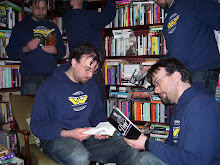Perec (1936-1982), a member of the Oulipo group who wrote using various formal restraints on their books' structures, seems to have begun this book on a dare, and then thoroughly enjoyed its creation. It's a kind of mystery novel about a man who wakes up with a fundamental sense of wrongness: he's one of the few who notices that 'e' seems to have vanished from the universe. When he himself vanishes soon afterwards, his friends try to track him down, using the various strange documents he has left behind. Along the way they encounter clever 'e'-less remixes of various great works of literature, including Moby Dick, Hamlet's 'To be or not to be' soliloquoy, Shelley's Ozymandias, and Poe's The Raven.
The English translation from the French was done by Gilbert Adair. Aside from Love and Death on Long Island, I've found Adair's own novels deeply unsatisfying. They take intriguing ideas and ruin them with characters who have all the psychological realism of a Shakespeare play performed by kindergarten students. This translation, though, must count as a masterpiece. After all, it was probably even harder to write than the original novel: Perec, at least, could take the story where he liked, whereas Adair was stuck with the very narrow aparameters of converting one specific text from one language to another without ever using the letter 'e'.
The new Vintage Classics edition of A Void also has a clever cover, by Jo Walker. Aside from the publisher/author names in the top corner, it consists only of the letter 'e'.

This cunning use of negative space is quite uncommon, and all the more effective for it.



























